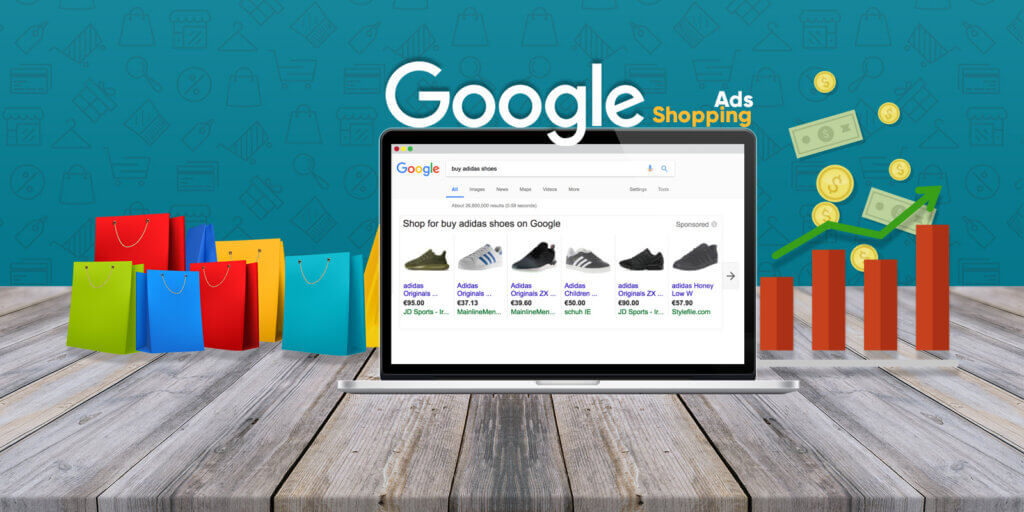Google Shopping Ads
Introduction
Google Shopping Ads, or Product Listing Ads (PLAs), are powerful advertising tools for e-commerce businesses. These ads appear at the top of Google search results, showcasing product images, prices, and details, making them an effective way to attract potential customers ready to purchase.
Benefits of using Google Shopping Ads:
- Increased visibility: Google Shopping Ads appear at the top of search results, making them more visible than regular search ads.
- Targeted audience: Google Shopping Ads target users searching for specific products, making them more likely to convert.
- Cost-effective: Google Shopping Ads uses a cost-per-click (CPC) model, which means you only pay when someone clicks on your ad.
- Improved ROI: Google Shopping Ads can provide a higher return on investment (ROI) than other forms of advertising because they target users actively searching for products.
Setting up Google Shopping Ads
Google Shopping Ads can be a powerful advertising tool for e-commerce businesses, allowing them to reach potential customers actively searching for products. To get started with Google Shopping Ads, there are a few steps you need to follow:
Creating a Google Merchant Center account:
Creating a Google Merchant Center account is the first step in setting up Google Shopping Ads. This is where you will upload your product feed, which includes information about each product you want to advertise, such as the product title, description, price, and image.
To create a Merchant Center account, go to the Google Merchant Center website and follow the prompts to sign up. You’ll need to provide basic information about your business and verify your website.
Uploading your product feed:
Once you have a Merchant Center account, you must upload your product feed. Your product feed should include all the information about each product you want to advertise. This consists of the product title, description, price, and image.
Optimizing your product feed with accurate and detailed information is essential to increase the chances of your products appearing in relevant search results. Follow Google’s product data specifications and requirements to ensure your feed is accepted.
Creating a Google Ads account:
It would help if you created a Google Ads account to create Google Shopping Ads. This is where you’ll make your Shopping campaigns, set bids and budgets, and manage your ads.
To create a Google Ads account, go to the Google Ads website and follow the prompts to sign up. You’ll need to provide basic information about your business and billing information.
Linking your Merchant Center and Google Ads accounts:
Once you have a Merchant Center and Google Ads account, link them together. This allows you to create ads and set bids and budgets using your product feed.
To link your accounts, go to your Google Ads account and navigate to the “Linked accounts” section. You can connect your Merchant Center account by entering your Merchant Center ID.
After you’ve linked your accounts, you can create your first Shopping campaign. To do this, go to the “Campaigns” tab in your Google Ads account and click the “+” button to create a new campaign. Select “Shopping” as the campaign type and follow the prompts to set up your campaign.
Setting up Google Shopping Ads involves creating a Google Merchant Center account, uploading your product feed, creating a Google Ads account, and linking your accounts. Once your accounts are set up, you can create your first Shopping campaign and start advertising your products to potential customers. Optimizing your product feed and campaigns ensures the best possible results.
Creating Effective Google Shopping Ads
Google Shopping Ads, or Product Listing Ads (PLAs), can be a powerful advertising tool for e-commerce businesses. Creating effective ads showcasing your products and attracting potential customers is essential to make the most of this advertising format. Here are some strategies for creating effective Google Shopping Ads:
Choosing the right keywords:
Choosing the right keywords is one of the essential elements of creating effective Google Shopping Ads. Use keyword research tools to identify your products’ most relevant and profitable keywords. Focus on keywords with high search volume and low competition to maximize your visibility and ROI.
Writing compelling ad copy:
While Google Shopping Ads don’t allow for traditional ad copy, the product title and description serve as the primary text for your ad. Use descriptive and engaging language to attract potential customers and highlight your product’s unique features and benefits. Include essential details like size, color, and material in the product title and description.
Optimizing product images:
Google Shopping Ads are highly visual, so high-quality images accurately representing products are essential. Follow Google’s image requirements and best practices to ensure your images are optimized for the platform. Use multiple photos, if possible, to showcase different angles or features of your products.
Setting bids and budgets:
Setting appropriate bids and budgets for your Google Shopping Ads campaigns is essential to maximize your advertising budget. Use historical data to determine the optimal offer for each product and set budgets based on your overall advertising goals and profitability. Monitor your movements regularly and adjust your bids and budgets as needed.
Utilizing product groups:
Product groups allow you to organize your products into categories based on attributes like brand, product type, or price range. This makes it easier to set bids and budgets for specific groups of products and target your advertising efforts more effectively. Be sure to organize your product groups logically and meaningfully to maximize the impact of your Google Shopping Ads.
Creating effective Google Shopping Ads involves choosing the right keywords, writing compelling ad copy, optimizing product images, setting bids and budgets, and utilizing product groups. Following these strategies, you can create ads that showcase your products and attract potential customers while maximizing your advertising budget and ROI. It’s essential to continually monitor and optimize your campaigns to ensure the best possible results.
Managing and Optimizing Google Shopping Ads
Once you’ve set up your Google Shopping Ads campaigns, it’s essential to continually monitor and optimize them to ensure the best possible results. Here are some strategies for managing and optimizing your Google Shopping Ads:
Monitoring performance metrics:
To determine the effectiveness of your Google Shopping Ads campaigns, it’s essential to track performance metrics like click-through rate (CTR), conversion rate, and return on ad spend (ROAS). Use these metrics to identify areas for improvement and make data-driven decisions about your advertising strategy.
Making bid adjustments:
Bid adjustments allow you to adjust your bids for specific products or groups based on their performance. For example, you may want to increase your recommendations for high-performing products or decrease your requests for low-performing products. Use historical data to determine the optimal offer for each product and adjust your bids regularly to maximize your ROI.
Testing and experimenting with ad variations:
To continually improve the effectiveness of your Google Shopping Ads, it’s essential to test and experiment with different ad variations. Try additional product images, ad copy, and product groups to see what resonates best with your target audience. Use A/B testing to compare the performance of different ad variations and make data-driven decisions about your advertising strategy.
Refining your targeting:
To reach your ideal audience and maximize the effectiveness of your Google Shopping Ads, it’s essential to refine your targeting. Use targeting options like geographic location, device type, and audience demographics to ensure your ads reach the right people. Continuously monitor and adjust your targeting based on performance metrics and user behavior.
Utilizing negative keywords:
Negative keywords allow you to exclude specific keywords from your campaigns to prevent your ads from appearing in irrelevant search results. Use negative keywords to eliminate outside traffic and ensure your ads are only shown to users likely to convert.
Managing and optimizing Google Shopping Ads involves monitoring performance metrics, making bid adjustments, testing and experimenting with ad variations, refining your targeting, and utilizing negative keywords. By following these strategies, you can continually improve the effectiveness of your Google Shopping Ads and maximize your ROI. It’s essential to constantly monitor and optimize your campaigns to ensure the best possible results.
Advanced Strategies for Google Shopping Ads
Google Shopping Ads can be a powerful advertising tool for e-commerce businesses, allowing them to reach potential customers actively searching for products. To take your Google Shopping Ads campaigns to the next level, consider implementing these advanced strategies:
Utilizing Remarketing Lists for Shopping:
Remarketing Lists for Shopping (RLSA) allows you to show ads to users who have previously interacted with your products or website. This can increase the likelihood of conversion, as these users are already familiar with your brand and products. Use RLSA to target users who have abandoned their cart or viewed specific products on your website.
Implementing Smart Shopping campaigns:
Brilliant Shopping campaigns use Google’s machine learning to optimize your campaigns for you. These campaigns show your ads across multiple channels, including search, display, and YouTube. Brilliant Shopping campaigns automatically adjust bids and placements to maximize your ROI, making them an excellent option for businesses with limited time or resources to manage their advertising campaigns.
Incorporating local inventory ads:
Local inventory ads allow you to showcase your in-store inventory to local customers searching for your products. These ads provide users important information like store location, availability, and pricing. Local inventory ads are an excellent option for businesses with physical storefronts looking to drive foot traffic and sales.
Expanding to international markets:
Expanding your Google Shopping Ads campaigns to international markets can help you reach a broader audience and increase sales. To grow to global markets, you’ll need to create separate campaigns for each country or region you’re targeting, optimize your product feed, and target each call. Consider working with a localization expert to ensure your campaigns are culturally appropriate and effective in each market.
Advanced strategies for Google Shopping Ads include utilizing Remarketing Lists for Shopping, implementing Smart Shopping campaigns, incorporating local inventory ads, and expanding to international markets. By implementing these strategies, you can take your Google Shopping Ads campaigns to the next level and reach a broader audience, increasing your sales and ROI. It’s essential to continually monitor and optimize your campaigns to ensure the best possible results.
Conclusion
Google Shopping Ads, or Product Listing Ads (PLAs), are powerful advertising tools for e-commerce businesses. These ads appear at the top of Google search results, showcasing product images, prices, and details, making them an effective way to attract potential customers ready to purchase.
To create effective Google Shopping Ads, choosing the right keywords, writing compelling ad copy, optimizing product images, and setting appropriate bids and budgets are important. Once your ads are live, it’s essential to continually monitor and optimize your campaigns to ensure the best possible results. This can include making bid adjustments, testing and experimenting with ad variations, refining your targeting, and utilizing negative keywords.
To take your Google Shopping Ads campaigns to the next level, consider implementing advanced strategies like Remarketing Lists for Shopping, Smart Shopping campaigns, local inventory ads, and expanding to international markets. These strategies can help you reach a broader audience and increase your sales and ROI.
Google Shopping Ads can be a highly effective advertising tool for e-commerce businesses. By following best practices for creating and managing your campaigns and implementing advanced strategies as appropriate, you can maximize the impact of your ads and increase your sales and profitability. It’s essential to continually monitor and optimize your campaigns to ensure the best possible results.
FAQs
How do google shopping ads work?
When users search for products related to your advertising, Google Shopping Ads display product listings at the top of Google search results. These ads feature a product image, title, price, and other relevant information, making it easy for users to compare products and make purchasing decisions.
To create a Google Shopping Ad, you must create a product feed that includes information about the products you want to advertise, such as the product title, description, price, and image. This feed is uploaded to your Google Merchant Center account and linked to your Ads account.
Once your product feed is uploaded, you can create a Shopping campaign in your Google Ads account. You’ll set a budget for your campaign, choose the products you want to advertise, and set bids for each product. When a user searches for a product related to what you’re promoting, Google’s algorithm will determine which ads to show based on the relevance of the products, the bid amount, and other factors.
When a user clicks on your ad, they’ll be taken to a product page on your website where they can complete their purchase. You only pay for your ad when a user clicks on it, so you only pay for the traffic you receive.
Optimizing your product feed and ad campaigns with accurate and detailed information, relevant keywords, and appropriate bids and budgets is essential to maximize your Google Shopping Ads. Continually monitoring and optimizing your campaigns can help you improve your ROI and reach more potential customers.
What triggers Google Shopping ads?
Google Shopping Ads are triggered by search queries related to your advertising products. When a user searches for a product or a product-related term on Google, Google’s algorithm will display relevant Google Shopping Ads at the top of the search results page.
The algorithm considers various factors to determine which ads to show, including the relevance of the products to the user’s search query, the bid amount, the quality of the ad and the product data, and the user’s location and device type.
Optimizing your product feed and ad campaigns with accurate and detailed information, relevant keywords, and appropriate bids and budgets is essential to ensure your Google Shopping Ads are triggered for relevant search queries. This can help increase the chances of your ads being displayed to potential customers actively searching for products like yours.
What is the difference between Google Ads and Google Shopping ads?
Google Ads and Google Shopping Ads are both advertising platforms offered by Google but have different purposes and formats.
Google Ads is an advertising platform that allows businesses to create and display text ads on Google search results in pages and other Google properties, such as YouTube and Google Display Network. These ads appear at the top and bottom of the search results page and are marked as “Ads” to distinguish them from organic search results. With Google Ads, businesses can target specific keywords, locations, audiences, and more to reach potential customers searching for products or services related to their business.
On the other hand, Google Shopping Ads is a type of ad format that allows businesses to showcase their products and prices directly on Google search results in pages. These ads appear at the top of the search results page and include product images, titles, fees, and other relevant information. With Google Shopping Ads, businesses can reach potential customers actively searching for products related to what they’re advertising.
In summary, the main differences between Google Ads and Google Shopping Ads are:
- Ad format: Google Ads are text-based ads that appear at the top and bottom of search results pages, while Google Shopping Ads are product-based ads that feature product images, titles, prices, and other details.
- Targeting: Google Ads allow businesses to target specific keywords, locations, audiences, and more, while Google Shopping Ads target users based on the relevance of the products to their search query.
- Ad goals: Google Ads can be used for various advertising goals, such as increasing website traffic or generating leads. In contrast, Google Shopping Ads primarily drive sales and product purchases.






